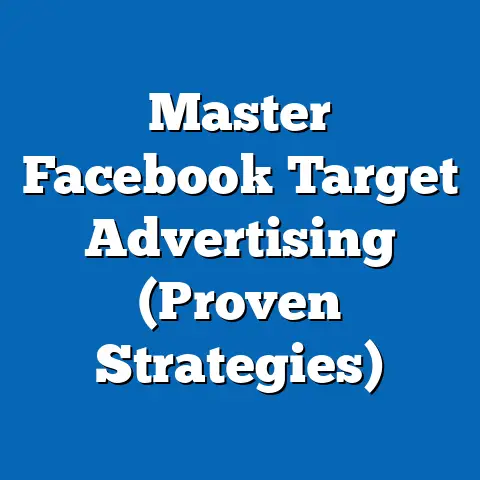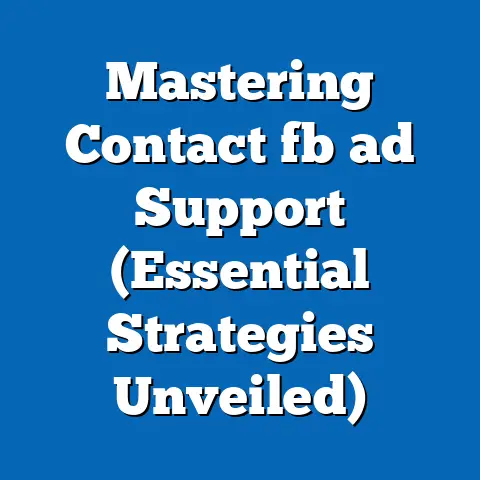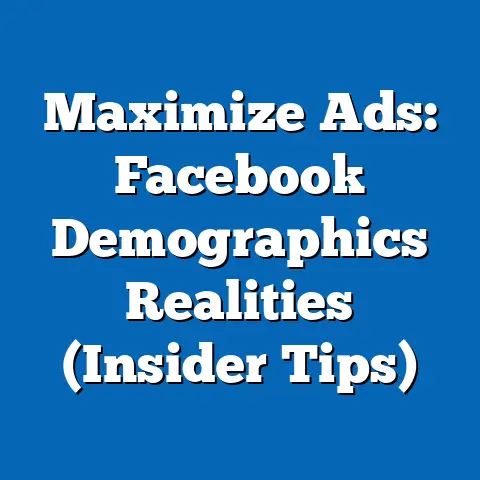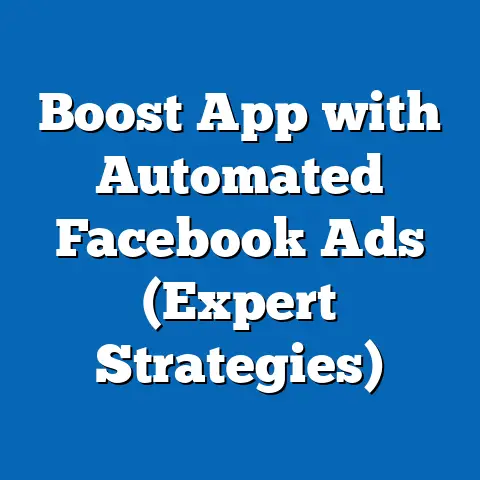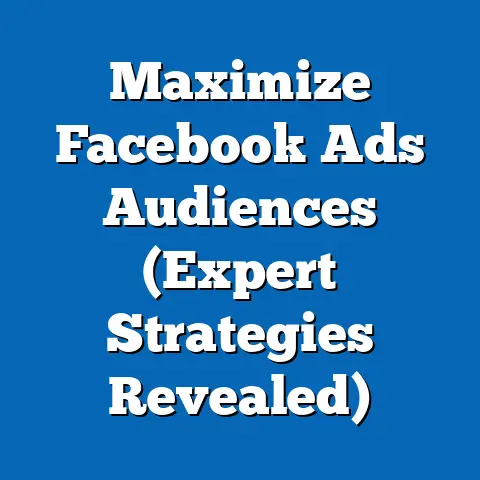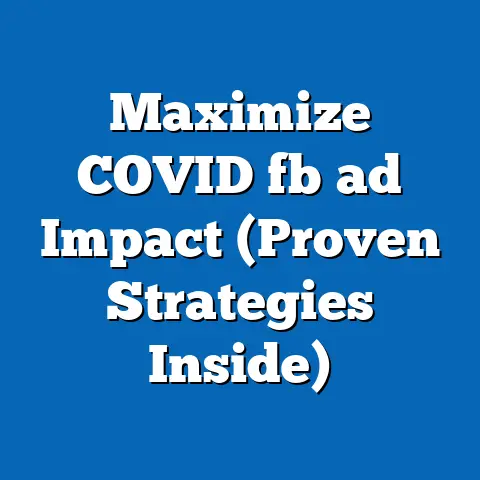See More Friends, Fewer Ads on Facebook (Pro Tips Unveiled)
Have you ever dreamed of scrolling through your Facebook feed and actually seeing posts from your friends and family, instead of being bombarded by endless ads? I know I have! I remember a time when Facebook felt more like a community, a place to connect with loved ones and share life’s moments. Now, it often feels like a digital billboard, with ads constantly vying for my attention. But what if you could reclaim your Facebook experience? What if you could curate a feed filled with genuine interactions, heartwarming news, and engaging content from the people and groups you truly care about?
The good news is, it’s possible! While Facebook’s algorithm might seem like an unyielding force, there are actually several strategies you can use to prioritize friends and minimize ad exposure. In this guide, I’ll unveil some pro tips and actionable steps you can take to see more of what you love and less of what you don’t. Let’s dive in and transform your Facebook experience into the vibrant digital world you’ve always envisioned.
Understanding Facebook’s Algorithm
Facebook’s algorithm is the invisible hand that shapes your News Feed. It’s a complex system designed to show you content that Facebook thinks you’ll find most interesting and engaging. But what exactly does that mean?
The algorithm analyzes countless factors, including:
- Engagement Metrics: Likes, shares, comments, and even the time you spend viewing a post. The more engagement a post receives, the higher it’s likely to appear in your feed.
- Relationship: How often you interact with a specific person or page. If you frequently like your best friend’s posts, their content will likely appear more prominently.
- Content Type: Whether it’s a photo, video, link, or text update. Facebook often prioritizes certain content types based on user preferences and current trends.
- Recency: How recently the post was published. Newer posts tend to rank higher than older ones.
So, where do ads fit into all of this? Well, Facebook makes money from advertising, so they’re strategically integrated into your feed. The algorithm aims to show you ads that are relevant to your interests, based on your browsing history, demographic information, and other data points. However, the sheer volume of ads can often overshadow posts from friends and family, leading to a less personal and more commercialized experience.
Why is this important to understand? Because knowing how the algorithm works empowers you to take control. By understanding the factors that influence your feed, you can strategically adjust your behavior and preferences to prioritize personal connections and minimize ad exposure.
Takeaway: The Facebook algorithm is a complex system that determines what you see in your News Feed. Understanding how it works is the first step towards reclaiming your Facebook experience and prioritizing connections over ads.
Customizing Your News Feed
One of the most effective ways to see more friends and fewer ads on Facebook is to customize your News Feed settings. Facebook provides several tools that allow you to tailor your feed to your specific preferences. Let’s explore some of the most useful options:
- “See First”: This feature allows you to prioritize specific friends or pages in your feed. By selecting “See First” for the people and pages you care about most, you ensure that their content always appears at the top of your News Feed. To use this, hover over a friend’s name, click the three dots, and select ‘See First’. I personally use this for my close family members so I never miss their updates.
- Unfollowing Accounts: If you’re constantly seeing posts from accounts that are overly promotional or irrelevant to your interests, unfollowing them is a great option. Unfollowing an account doesn’t mean you’re no longer friends or fans; it simply means you won’t see their content in your News Feed. To unfollow, click the three dots on a post from the account and select ‘Unfollow’.
- “Snooze” Feature: Need a temporary break from a particular person, page, or group? The “Snooze” feature allows you to temporarily hide their content from your News Feed for 30 days. This can be particularly useful for accounts that are posting a lot of promotional content or triggering content during a specific time. To snooze, click the three dots on a post and select ‘Snooze’.
- Ad Preferences: Take control of the ads you see by adjusting your ad preferences. You can tell Facebook which topics you’re interested in and which you’re not, which can help to improve the relevance of the ads you see or reduce the number of ads altogether. You can access your ad preferences through your Facebook settings.
- News Feed Preferences: Facebook also has a News Feed Preferences section where you can choose who to prioritize, unfollow accounts, and reconnect with accounts you’ve previously unfollowed. This can be a helpful way to manage your News Feed in bulk. You can access this by clicking the down arrow in the upper-right corner of Facebook and choosing ‘Settings & Privacy,’ then ‘News Feed Preferences.’
Example: I had a friend who started a new business and was constantly posting promotional content on Facebook. While I supported her, her posts were flooding my feed and pushing down content from other friends and family. I used the “Snooze” feature for 30 days, which gave me a break from her promotional content without unfollowing her altogether.
Pro Tip: Regularly review your News Feed settings and adjust them as your interests and relationships evolve. This will help you maintain a personalized and friend-focused Facebook experience over time.
Takeaway: Customizing your News Feed settings is a powerful way to prioritize friends, minimize ad exposure, and create a more personalized Facebook experience.
Engaging with Friends
Beyond adjusting your News Feed settings, actively engaging with your friends’ content is crucial for seeing more of what you want. The more you interact with your friends’ posts, the more likely Facebook’s algorithm is to show you their content in the future.
Here’s why engagement matters:
- Signals to the Algorithm: When you like, comment, or share a friend’s post, you’re signaling to Facebook that you value their content. The algorithm interprets this as a sign that you want to see more from that person.
- Strengthens Relationships: Engaging with your friends’ content also strengthens your relationships on Facebook. It shows them that you’re interested in what they have to say and that you value their presence in your digital life.
- Boosts Visibility: When you engage with a friend’s post, it can also boost its visibility to your other friends. This can help to create a more vibrant and interactive community on Facebook.
Here are some practical tips for fostering meaningful interactions with your friends:
- Like and Comment: Take a moment to like and comment on your friends’ posts, especially those that resonate with you. A simple “like” can go a long way, but a thoughtful comment can spark a conversation and deepen your connection.
- Share Memories: If you come across an old photo or post that reminds you of a friend, share it with them and tag them in the post. This can be a fun way to reminisce and reconnect.
- Start Conversations: Don’t be afraid to start conversations with your friends on Facebook. Ask them about their day, share your thoughts on a topic, or simply say hello.
- Use Facebook’s Features: Take advantage of Facebook’s features like polls, events, and groups to engage your friends in a more interactive way. Create a poll to get their opinions on a topic, invite them to an event you’re hosting, or join a group related to a shared interest.
Personal Experience: I started making a conscious effort to comment on my friends’ posts more often, even if it was just a simple “Great photo!” or “Sounds like fun!” I noticed that I started seeing more of their content in my feed and felt more connected to them overall.
Takeaway: Actively engaging with your friends’ content is a powerful way to signal to Facebook that you value their presence and want to see more of what they have to say.
Utilizing Groups and Pages
Facebook groups and pages can serve as valuable alternatives for connection while minimizing ad exposure. Groups, in particular, offer a unique space for communities to form around shared interests, hobbies, or causes.
Here’s how you can leverage groups and pages to enhance your Facebook experience:
- Join Relevant Groups: Search for groups related to your personal interests, hobbies, or professional field. Joining these groups can expose you to like-minded individuals and engaging content without the constant barrage of ads that you might encounter in your News Feed.
- Participate Actively: Once you’ve joined a group, actively participate in discussions, share your thoughts, and contribute to the community. This will help you build relationships with other members and create a more fulfilling social media experience.
- Create Your Own Group: If you can’t find a group that meets your specific needs, consider creating your own. This can be a great way to connect with others who share your passions and build a community around a common interest.
- Follow Specific Pages: While pages can still feature ads, following specific pages that align with your interests can provide you with valuable content and information without overwhelming you with promotional material. Choose pages that offer engaging, informative, or entertaining content that you genuinely enjoy.
Example: I’m a big fan of photography, so I joined several Facebook groups dedicated to the topic. I’ve learned so much from other members, shared my own photos, and even made some new friends. The groups provide a welcome escape from the noise and clutter of my News Feed.
Tip for Finding the Right Groups: Look for groups with active discussions, a clear focus, and a welcoming community. Avoid groups that are overly promotional or spammy.
Takeaway: Facebook groups and pages offer a valuable alternative to the traditional News Feed, providing a space for connection, community, and engaging content with less ad exposure.
Mindful Scrolling and Digital Detox
While customizing your News Feed and engaging with friends can help to improve your Facebook experience, it’s also important to practice mindful scrolling and take breaks from social media altogether.
Here’s why mindful scrolling and digital detox are important:
- Reduces Stress and Anxiety: Constant exposure to social media can contribute to stress and anxiety, especially if you’re constantly comparing yourself to others or feeling overwhelmed by negative news.
- Improves Focus and Productivity: Taking breaks from social media can help you to improve your focus and productivity. It allows you to disconnect from distractions and concentrate on tasks that require your attention.
- Enhances Real-Life Connections: Spending less time on social media can free up more time for real-life interactions with friends and family. This can help you to strengthen your relationships and build a more fulfilling social life.
Here are some tips for practicing mindful scrolling and digital detox:
- Set Limits on Daily Usage: Use Facebook’s built-in tools or third-party apps to set limits on your daily usage. This can help you to be more mindful of how much time you’re spending on the platform.
- Schedule “Digital Detox” Periods: Plan regular “digital detox” periods where you completely disconnect from social media for a set amount of time. This could be for a few hours each day, a full day each week, or even a longer period like a weekend or vacation.
- Curate Your Feed with Intention: Before you start scrolling, take a moment to consider what you want to get out of your Facebook experience. Are you looking to connect with friends, learn something new, or simply be entertained? Curate your feed with intention, focusing on content that aligns with your goals.
- Engage in Activities Outside of Facebook: Spend time engaging in activities that you enjoy outside of Facebook, such as reading, exercising, spending time in nature, or pursuing a hobby. This can help you to reduce your reliance on social media and build a more balanced lifestyle.
Personal Experience: I used to spend hours mindlessly scrolling through Facebook each day. I realized that it was making me feel stressed and anxious, so I started setting limits on my daily usage and scheduling regular digital detox periods. I’ve noticed a significant improvement in my mood, focus, and overall well-being.
Takeaway: Mindful scrolling and digital detox are essential for maintaining a healthy relationship with social media and enhancing your overall well-being.
Conclusion
Reclaiming your Facebook experience and prioritizing connections over ads is a journey, not a destination. By understanding Facebook’s algorithm, customizing your News Feed, engaging with friends, utilizing groups and pages, and practicing mindful scrolling and digital detox, you can take charge of your online experience and create a Facebook that serves as a platform for genuine connections, fostering a sense of community and belonging in the digital age.
I urge you to start today by taking small steps toward a more personalized and friend-focused Facebook experience. Adjust your News Feed settings, engage with your friends’ content, explore relevant groups, and schedule regular digital detox periods. You might be surprised at how much of a difference these small changes can make.
Envision a Facebook that truly reflects your values, interests, and relationships. A Facebook where you feel connected, inspired, and supported. A Facebook where you see more of what you love and less of what you don’t. The power to create that Facebook is in your hands. So, go ahead and start building the digital world you’ve always envisioned.

